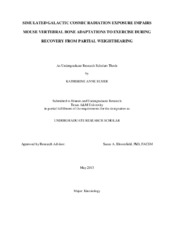| dc.description.abstract | Partial weightbearing that simulates Lunar gravity (one-sixth of Earth’s gravitational force) results in a loss of bone volume. High-energy radiation like that found in galactic cosmic radiation exposure also negatively affects the skeleton. Because resistance training is the most effective exercise mode to counteract disuse-induced bone loss, this experiment combined low-dose, high-energy simulated galactic cosmic radiation (GCR) exposure, followed by a period of partial weightbearing (PWB), and then a period of climb training resistance exercise or normal cage activity during recovery. Ex vivo micro-computed tomography (μCT) scans were performed by Matthew Allen, PhD at the Indiana University School of Medicine to quantify cancellous bone microarchitecture in the 4th lumbar vertebral body before biomechanical compression tests were performed at Texas A&M University. Ash weights were calculated on the fifth lumbar vertebrae. Means for cancellous bone volume (%BV/TV), trabecular thickness (Tb.Th.), trabecular number (Tb.N.), ash weight, and maximum stress from Day 42 of the experiment were compared to Day 21 means using unpaired t-tests to determine the changes occurring through the recovery period. These change scores were then analyzed using a two-way ANOVA to determine differences across experimental groups. Exercise had no significant effect on ∆BV/TV or ∆Tb.Th., but ∆BV/TV and ∆Tb.Th. were significantly lower in RAD groups than in SHAM groups (p<0.001). Additionally, Ex SHAM bones showed gains in cancellous bone mass and trabecular thickness during the recovery period. SHAM groups increased in trabecular Tb.Th. during recovery, while the trabeculae of RAD bones became thinner. ∆Tb.N. was significantly higher in exercised groups than non-exercised groups (p<0.05), but no significant differences in ∆Tb.N. were shown between RAD and SHAM groups. Ash weights showed significant differences in bone mineral content between Ex RAD and Ex SHAM groups. While maximum stress data did not show significant changes during recovery, the trends mirror those seen in other tests of bone integrity. These data suggest that GCR exposure diminishes the ability of bone to respond to exercise during recovery form a period of reduced weightbearing. | en |


